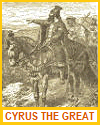| Results of the Industrial Revolution Printable PDF Outline |
|---|
| www.studenthandouts.com ↣ World History ↣ Industrial Revolution ↣ Industrial Revolution Outlines & PPTs |
 I. Results of the Industrial Revolution
I. Results of the Industrial Revolutiona. Economic changes i. Expansion of world trade ii. Factory system iii. Mass production of goods iv. Industrial capitalism v. Increased standard of living vi. Unemployment b. Political changes i. Decline of landed aristocracy ii. Growth and expansion of democracy iii. Increased government involvement in society iv. Increased power of industrialized nations v. Nationalism and imperialism stimulated vi. Rise to power of businesspeople c. Social changes i. Development and growth of cities ii. Improved status and earning power of women iii. Increase in leisure time iv. Population increases v. Problems—economic insecurity, increased deadliness of war, urban slums, etc. vi. Science and research stimulate II. Economic changes—expansion of world trade a. Increased production meant that industrialized nations produced more than could be consumed internally b. Sought new foreign markets for selling manufactured goods c. Bought many raw materials from foreign markets d. New iron, steam-powered ships, along with other technological advances, made international trade (and travel) cheaper, safer, and more efficient III. Economic changes—expansion of world trade—free trade and tariffs a. Free trade—trade without barriers or tariffs—was initially used b. As nations competed for markets, protective tariffs were put in place to limit foreign competition within an industrialized nation and its colonies c. Motivation was to protect businesses in the home country and colonies, but this often meant people in the home country or colonies paid inflated prices for goods IV. Economic changes—factory system possible due to standardized parts a. Eli Whitney is popularly credited with the invention of interchangeable parts in the late 1700s i. But interchangeable parts had already been used in Europe b. Before the late 1700s, each part of an item (like a musket) was made individually by a single person, with each part made to fit the whole c. Standardized, or interchangeable, parts were created en masse to make a lot of duplicate products (such as hundreds of muskets) d. Manufacturers decided upon standard sizes for their goods and created large quantities of components i. Such as deciding that a musket barrels should be two feet long and making 100 duplicate musket barrels, then deciding that triggers for these muskets should be two inches tall and making 100 2-inch triggers e. Standardized parts could be kept in a set location in a factory i. As a worker assembled each article, he or she would take whatever parts were needed from a bin of standardized (interchangeable) parts 1. Henry Ford later improved on this idea with the moving assembly line V. Economic changes—factory system perfected with the assembly line a. Developed by Henry Ford between 1908 and 1915 b. Brought the work to the worker instead of the worker to the work c. Product moves along a conveyor belt, with each worker contributing labor along the way to create the finished product VI. Economic changes—factory system—assembly line brings division of labor a. Assembly line brings the work to the worker, saving time b. Each worker specializes in one part c. An automobile worker may spend 30 years in a factory only ever putting passenger-side doors on motor vehicles d. Focusing on one aspect of production can be repetitive but can also make a worker an expert at that particular aspect VII. Economic changes—factory system a. Manufacture comes from the Latin manu and facere, meaning to make by hand i. But during the Industrial Revolution, the meaning of manufacturer switched from the person who made an article by hand to the capitalist who hired workers to make articles b. Workers no longer owned the means of production (simple hand tools) i. Instead, the newer means of production (expensive machinery) were owned by the capitalist VIII. Economic changes—mass production of goods a. Motor vehicle production in the United States i. 1895—33,000 motor vehicles ii. 1910—181,000 motor vehicles iii. 2000—5,542,000 passenger cars alone b. Factors contributing to mass production i. Standardized (or interchangeable) parts ii. Assembly line iii. Labor division and specialization c. Mass production meant more items were produced at lower costs i. More people could afford to buy manufactured goods, which in turn spurred demand IX. Economic changes—industrial capitalism and the working class a. Pre-Industrial Revolution rural families did not rely solely on wages for sustenance i. Owned their own farms or gardens where they raised most of their own food ii. Made their own clothing iii. Unemployment was rare b. Industrialization destroyed workers' independence i. Workers in cities did not have the means to grow their own food or make their own clothing ii. Workers relied entirely upon their employers for wages with which they bought everything they needed X. Economic changes—industrial capitalism's risks a. Workers came to rely entirely on their employers for their livelihoods i. No more small family farms or gardens to provide extra food ii. No more day-laboring for a neighboring farmer to earn extra money iii. When the factory slowed down, the worker had nowhere to go for sustenance b. Entrepreneurs assumed enormous risk in establishing new enterprises i. No more workers working from home—capitalists had to supply a factory ii. No more custom orders—capitalists had to anticipate demand iii. No more at-will laborers—workers relied on capitalists for steady labor XI. Economic changes—industrial capitalism a. The financial investments required to run large industries brought about modern capitalism b. Capital = wealth that is used to produce more wealth c. Entrepreneur = person who invests his or her money in a business to make a profit d. Corporation = company owned by stockholders who have purchased shares of stock i. Actual running of the company left to hired managers rather than to the stockholders ii. As industries grew and small business operations fell into obscurity, the relationship between workers and business owners disintegrated XII. Economic changes—industrial capitalism's problems a. Small manufacturers cannot compete with large corporations b. Consumers must buy from large corporations c. Workers have had to fight for decent wages and working conditions d. Large corporations can influence governments XIII. Economic changes—increased standard of living a. Mass production made manufactured goods less expensive, so more people could afford them b. Standard of living wasn't raised for everyone—factories paid low wages, and many immigrants and rural-to-urban migrants lived poorer lives than their parents and grandparents had lived XIV. Economic changes—unemployment a. Overproduction i. Also called under-consumption ii. Mass production anticipates demand—if goods don’t sell, a manufacturer produces less and lays off workers b. Recession i. Overproduction across many industries with widespread layoffs c. Depression i. Long-lasting recession XV. Political changes—decline of the landed aristocracy a. Before the Industrial Revolution—power was in the hands of the landed aristocracy and monarchs i. Landed aristocracy refers to lords, dukes, etc., who owned the land ii. Although vassalage was pretty much gone from Europe by the 18th century, the working relationship between lords (landowners) and peasants (who worked the land) remained the same 1. Peasants either worked the land for lords or rented land from them iii. Wealth was based on agriculture, which meant that those who owned the most land were the wealthiest 1. Landed aristocracy owned and controlled the most land, making this the wealthiest and highest-ranking socio-economic group b. Industrial Revolution—factories became more valuable than land i. Wealth of the aristocracy dwindled ii. Growing middle class, with wealth based in industry, wanted more political power XVI. Political changes—decline of the landed aristocracy—case study—the Corn Laws a. Problem: British landowners and agriculturalists (lords and farmers) wanted high prices for their corn i. Solution: Tariffs known as the Corn Laws established in 1815 b. New problem: The growing working class could not afford corn i. Solution: Repeal of the Corn laws in 1846 c. Newer problem: The price of corn declined following the repeal of the Corn Laws, decreasing the wealth, power, and prestige of the landed aristocracy in Great Britain i. Solution: There was no solution 1. The landed aristocracy began its fall from economic and political power 2. Economic and political power shifted to the wealthy capitalist, middle, and working classes XVII. Political changes—growth and expansion of democracy a. The middle class grew during the Industrial Revolution i. Gained more rights b. The working class effectively began with the Industrial Revolution i. The working class fought for rights in the workplace ii. The working class demanded and earned a voice in government XVIII. Political changes—increased government involvement in society a. Government actions to help workers i. Legalization of unions ii. Established minimum wage iii. Standards for working conditions iv. Forms of social security b. Government actions to help consumers i. Regulation and inspection of goods and foodstuffs c. Government actions to help businesses i. Laws to stop or limit monopolies ii. Some governments took control of vital industries XIX. Political changes—increased power of industrialized nations a. With wealth came power b. Imperialism expanded c. Imperialistic, industrialized nations built up their navies to gain and protect assets XX. Political changes—nationalism and imperialism stimulated a. Increased production meant an increased need for raw materials b. Industrialized nations expanded their colonial empires and spheres of influence in their search for more raw materials i. Worldwide scramble for colonies ii. Fought the peoples in the lands they controlled iii. Fought one another for colonies and spheres of influence c. Governments saw imperialist expansion as the key to continued industrial growth and wealth XXI. Political changes—rise to power of businesspeople a. Along with the working classes, businesspeople gained political rights b. "Captains of industry" or "robber barons—along with financiers i. Wealth brought political influence XXII. Social changes—development and growth of cities a. Paris, France i. 18th century—600,000 people ii. Circa 1900—over 2,714,000 in the Paris urban area iii. Circa 2000—over 11,000,000 in the Paris urban area b. London, England i. 18th century—500,000 people ii. Circa 1900—over 6,200,000 in the London urban area iii. Circa 2000—over 7,100,000 in the London urban area c. Rural-to-urban migrants = people who left the countryside to live in cities d. A sign of an industrialized nation is that a large proportion of the population lives and works in urban areas XXIII. Social change—development and growth of cities—case studies: Liverpool and Manchester a. Liverpool i. 1800—population under 100,000 ii. 1850—population over 300,000 (part of the increase due to the Irish fleeing the potato famine) iii. 1900—population over 700,000 iv. Major British port city which grew during the Industrial Revolution v. Population peaked in the 1930s and has been declining ever since due to the decline in manufacturing and imperialism b. Manchester i. 1800—population circa 328,000 ii. 1850—population circa 1,037,000 iii. 1900—population circa 2,357,000 iv. Nicknamed "Cottonopolis" in the mid-to-late 19th century because of its textile factories v. Began to decline after the Industrial Revolution but has stabilized due to new industries and greater business diversification XXIV. Social changes—improved status and earning power of women a. Initially, factory owners hired women and children because they worked for lower wages i. This brought many women, otherwise impoverished, to cities to work in factories ii. From England to Japan, young women moved from farms to factories, hoping to earn money 1. Risked low wages, sexual harassment, and issues adjusting to urban living iii. Governments limited the work of children and, at times, of women b. Women gained economic power and independence i. Before industrialization, it was almost impossible for a woman to remain single and live on her own ii. Factories and urban centers attracted women in large numbers iii. Women fought for and eventually gained political rights XXV. Social changes—increase in leisure time a. Labor-saving devices were invented and produced i. Vacuum cleaners ii. Washing machines iii. Refrigerators b. Entrepreneurs and inventors developed new forms of entertainment i. Moving pictures ii. Amusement parks c. Birth of the weekend i. Traditionally, Western nations had Sunday (the Christian day of rest) as the only day off from work ii. Saturday was added (after the struggles of Jewish labor unionists) to accommodate the religious observances of Jewish factory workers (whose Sabbath, or Shabbat, runs from Friday at sundown to Saturday at sundown) XXVI. Social changes—population increases a. Agricultural Revolution ↘ i. Increased food production ↘ 1. Lower food prices ↘ a. People ate more ↘ i. More healthy babies were born ↘ 1. Population skyrocketed b. Europe i. 1750—144,000,000 people ii. 1900—325,000,000 people c. England i. 1750—11,000,000 people ii. 1900—30,000,000 people d. Many people immigrated to industrialized countries i. Numerous nationalities to the United States ii. Irish to Manchester and Liverpool in England e. Population growth in industrialized nations required growing even more food XXVII. Social changes—problems a. Monotony of assembly lines and factory life b. Loss of craftsmanship in manufactured goods c. War became more deadly as weapons became more technologically advanced and were mass produced d. Economic insecurity—workers relied entirely on their jobs for sustenance XXVIII. Social changes—science and research stimulated a. Scientific and technological discoveries became profitable instead of simply beneficial b. Companies and governments were willing to invest in research and development c. Patent law i. Came into its modern form under England's Queen Anne (reigned 1702-1714) ii. Inventors have the exclusive right to produce their new inventions for a period of time XXIX. Review Questions a. Describe the economic, political, and social changes which resulted from the Industrial Revolution. b. What risks did workers face from the factory system of production? c. How did women benefit from the Industrial Revolution? d. Imagine that you are a government official in a developing nation. What lessons for your country might you take away from a study of the Industrial Revolution? What pitfalls might you want to avoid? Click here to print. It prints as eight pages, or as four double-sided sheets. |
 |  |  |  |  |
| www.studenthandouts.com ↣ World History ↣ Industrial Revolution ↣ Industrial Revolution Outlines & PPTs |








